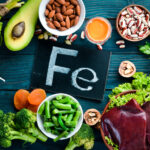Are you affected? Discover how an iron deficiency threatens the U.S. population, especially women
 (NaturalHealth365) Important news if you’re a young woman or if you have women in your life that you care about: 1 in 3 American girls and young women between the ages of 12 and 21 are living with iron deficiency, says a new study published in the Journal of the American Medical Association (JAMA).
(NaturalHealth365) Important news if you’re a young woman or if you have women in your life that you care about: 1 in 3 American girls and young women between the ages of 12 and 21 are living with iron deficiency, says a new study published in the Journal of the American Medical Association (JAMA).
Unfortunately, we can’t say we’re surprised to hear that so many women live with this nutrient deficiency. After all, it’s well-known that many Americans have insufficient or deficient levels of other vital nutrients, including vitamin B6, vitamin D, magnesium, folate, iodine, and vitamin C … with a nutrient-poor Standard American Diet (SAD) largely to blame. Fortunately, simple strategies can help you consume and absorb more iron.
Over a third of adolescent girls, young women are deficient in important nutrient, JAMA study reveals
The JAMA study published online in late June found that based on data spanning 2003 and 2020, 39% of American females between the ages of 12-21 had iron deficiency, and 6% had iron deficiency anemia. Iron deficiency anemia is when a person’s body does not produce enough red blood cells. It turns out that the mineral iron is essential for helping the body make particular proteins called hemoglobin and myoglobin, which red blood cells use to carry oxygen.
While iron deficiency might not have any associated symptoms, symptoms of iron deficiency anemia include:
- Fatigue and decreased energy
- Dizziness or lightheadedness
- Shortness of breath
- Fluttering or noticeable heartbeats (palpitations)
- Pale skin
- Ringing in the ears
- Headache
- Altered sense of taste
- Persistent itchiness
- Sore or inflamed tongue
- Hair loss
- Painful ulcers in the mouth
- Spoon-shaped, brittle nails
- Cold hands and feet
- Restless leg syndrome (RLS)
Another disturbing symptom to note: A condition known as pica, or the desire to eat non-food or non-nutritive items like paper, ice, dirt, and starch.
So, other than being young and female, who’s at risk? Iron deficiency anemia can affect anyone but is more likely to affect pregnant women, women with heavy periods, people who are vegetarians, people who donate blood regularly, people with low amounts of iron in their diet, anyone who has decreased ability to absorb iron (often due to conditions like celiac disease), and chronic blood loss (which, in addition to menstruation, can be due to underlying issues like a peptic ulcer, a hiatal hernia, a colon polyp, colorectal cancer, or regular use of over-the-counter pain relievers).
The JAMA researchers note that “iron deficiency and iron-deficiency anemia are common, underappreciated conditions with significant morbidity and mortality despite widespread availability of effective treatment.” They also point out that the Centers for Disease Control and Prevention (CDC) “recommends anemia screening for nonpregnant female adolescents and women every 5 to 10 years.”
If you’re concerned about yourself or your loved one, we recommend contacting a trusted (holistic) healthcare provider to learn about screening.
Three tips to ensure you and your loved ones are getting enough iron
Untreated iron deficiencies can impair your quality of life and lead to serious health issues, including heart problems, premature births and low birth weight newborns (in the case of iron-deficient pregnant women), and delayed infant and child growth and development. So, ensuring you get enough of this important nutrient is essential for your well-being.
Here are three tips to help boost your iron levels:
- Eat iron-rich foods, including organic 100% grass fed meat, pasture raised poultry, wild seafood, dark leafy green vegetables, beans, dried fruits like raisins and apricots (look for no added sugar), and peas.
- Consume your iron-rich foods with foods that contain vitamin C. Vitamin C helps your body absorb iron, so try to pair your iron-containing foods with things that contain vitamin C, such as organic citrus fruits, broccoli, kiwi fruits, tomatoes, strawberries, peppers, and melons.
- Consider a high-quality iron supplement if you have a significant deficiency, but speak with a trusted (holistic) healthcare provider first. Iron supplementation can lead to unwanted side effects like backaches, flushing, nausea, and a metallic taste in the mouth.
Sources for this article include:
Organicconsumers.org
Thehill.com
JAMAnetwork.com
Biomedcentral.com
NHS.uk
CDC.gov
Mayoclinic.org
Mayoclinic.org



